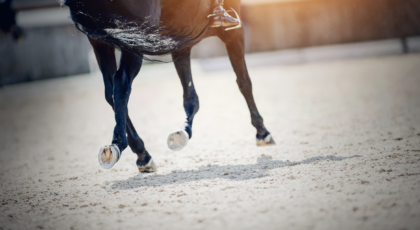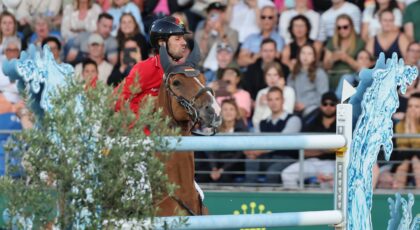And when you’re stuck in the proverbial rut, what can you do?
Six years ago, I was standing outside my horse’s stall just minutes before mounting up to compete in my divison’s Sunday jumper classic. I had my pump-up Beyoncé mix on, full-volume in my ears. And my God, did I need it.
I’d recently relocated from Indiana, where my trainer was based, back home to New York. But I had returned to the Midwest and the World Equestrian Center in Ohio to compete with my horse for a few weeks. I may have had dreams of reclaiming my former glory, but the reality was, my skills were rusty, my horse was out of his training program, and while I probably should have dropped down a division to allow for these variables, I was (am) stubborn. Despite my trainer gently suggesting this option, I pushed on, fell off (fell off again) and ended up bruising not just my tailbone but my self-confidence and my horse’s as well. The latter, it goes without saying, is much more difficult to recover from.
But that was then, and this is now.
More than mid-way through the winter season, I find myself scrolling through my social feeds and taking stock of friends’ successes in the show ring. (It goes without saying, hardly anyone posts failures, but that’s another story for another time.) I don’t begrudge my friends their moments in the sun—quite the contrary, I’m happy for them! But when you’re not achieving the same kinds of results yourself, or being able to train and compete the way you want to, it can be easy to let the Insta-gremlins get you down.
After my aforementioned struggle in Ohio, years ago, things got better. I didn’t quit (some people do) and I didn’t get a new horse (many people do this). I went home and stopped trying to make my long-distance training relationship work. I found an amazing new coach closer to home, and when I returned to the ring the following winter at the Winter Equestrian Festival (WEF) in Wellington, my horse and I had great rounds on an even bigger stage.
But great rounds come, and great rounds go. Success in riding is, at least in my experience, a cyclical enterprise. One season you’re raking in the tri-colors, paying checks, and can’t think of enough hit music tracks to pair with your flawless rounds on social. The next, you’re banging your head against the wall, wondering how any sane individual would invest the kind of time, money, and mental health demanded by this bonkers sport anyway.
Certainly, if you have enough money, and the emotional ability to buy, sell, and trade horses like snow tires—success is, to an extent, for sale. There will always be a “better” horse out there, and if you can afford to find it when things start to go south, more power to you. If, on the other hand, you’re like me and view your relationship with horses as a more long-term, monogamous commitment, you learn to take the ups and downs as the come. (Marriage!)
After having my most successful show season to date this summer (hello, peak!), I made a few, ‘rusty ammie’ mistakes with my current horse in Florida this season. Suddenly, I’m on the cusp of what I recognize as another crisis of confidence in my riding (hello, valley!). After years waiting for my young horse to develop into the partner I always dreamed he’d become, he’s there, and better than I could have imagined. I, on the other hand, feel like I’m out of practice and flailing, all the while feeling a tremendous pressure (in my own mind) to ride up to the level he deserves.
The good news? My horse isn’t the only one that’s matured. Coming up on my 30th year in the sport, I recognize now that my disastrous season in Ohio wasn’t a one-off. And, guess what? My stellar rounds this summer weren’t either. Periods of self-doubt, unfortunately, come with the territory, not just when it comes to this sport, but anything you care about deeply. I don’t pretend to be any kind of mental coach, but entering this latest chapter of uncertainty in my own riding, I plan to lean hard on the perspectives I’ve gained over the years. Maybe you can, too.
Here are five tips that have worked for me when it comes to getting out of a riding rut—and maybe, just maybe, making those cyclical ups and downs in the ring a little less dramatic:
Step #1: Adjust your expectations accordingly.
When you feel you’re hitting the skids, a great first step is to adjust your expectations to reflect not your potential ability, but your current confidence level (don’t make my mistake!). Taking some pressure off yourself can go a long way to help calm your jitters and right the ship. For instance, my own goal this winter was to try to move up a jumper division, but I’m realizing that may not be in the cards this season. I’m not going to take on bigger fences while it’s clear I still have some dust to knock off the ol’ skillz. And while success in the ring may be cyclical, your goals need to be flexible too in order to (honestly) reflect where you are on the curve.
Step #2: (Really), don’t quit.
Some hard truth: there are moments when I’ve wondered what it would be like to dismount, put my horse away, head home, and hang up my boots for a while—especially lately. A little time off can be good for refocusing your priorities, the idea being that it hopefully helps to remind you what you love about the sport. But, for my particular case of the yips, I don’t think time away will help. I need more practice, not less. Which is why, remembering my “why” and plugging on when my mental game is in the toilet can feel so hard. Like, 30 minutes of jumping without stirrups hard. But quitting? I plan to keep that as a last (last) resort.
Step #3: Get real with your trainer.
This one’s a doozy, at least for me. Though she’s likely already seen the writing on the wall, explaining my feelings to my trainer, and the fact that we may need to adjust our expectations this season, is something I dread. In years past, I’ve made the mistake of worrying too much about letting a trainer down, embarrassing him or her, or dealing with those awful feelings that their confidence in me was misplaced. If I’m being honest, I do still struggle with this one, but I know it’s better to be frank with my trainer about my needs and my current state of mind (i.e. jumping a little lower; making time for additional lessons even if it means giving up show day; putting a goal on the back-burner for now) than to push through and create a bigger, potential problem for myself and/or my horse.
Step #4: Don’t be a passive part of the process.
I’m a bit of a control-freak, and inaction makes me crazy. With my horse and coach in Florida for the season, I’m limited with the amount of training I can do at home. But I still want to feel like I’m grabbing the bull by the horns and doing what I can to improve on my own time. So, I’m trying to get creative. Can I use my older horse at home who is currently working back from injury to strengthen my two-point and ride without stirrups a little bit? Sure! Can I study old videos from the summer and earlier this season to see what went right and what went wrong? You bet. Can I hit the gym to improve my own fitness? Hell yes. On and off the horse, there are always ways to be part of a solution, and if you’re like me, you’ll realize it feels good to do something.
Step #5: Allow yourself some grace.
“Grace” is a current wellness buzz word (I hate wellness buzz words), but for good reason. For me, “giving grace” walks a fine line between finding deserved compassion for your struggles and making excuses. But there’s room, I think, for both Lindsay Lohans in this Parent Trap remake. Speaking for a friend **raises hand** who is currently sludging through the psychological detritus with you, it’s more than valid—essential, really— to cut yourself some slack. Riding is hard. Riding as an adult amateur, with work, family, and other commitments, is really hard. If you can remind yourself to zoom out, and think about where you and your horse will be in two- or ten-months’ time, it’s easier to see this low period for what it is on the spectrum. Annoying, scary, frustrating, disappointing, anxiety-inducing—all valid. But if there’s anything to learn from this little exercise, it’s that there’s also a good chance that it’s temporary.


 February 20, 2023
February 20, 2023 

























